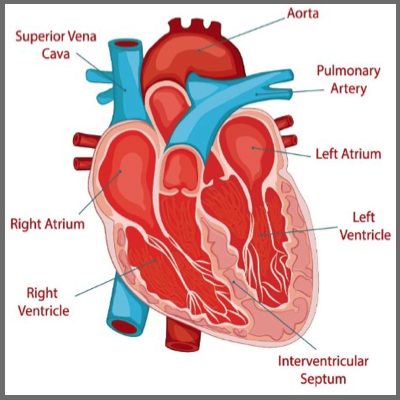Major organ systems work as co-ordinated unit to supply the oxygen needed to power muscle contractions. Oxygen enters the bloodstream via the lungs and is delivered to working muscles. Here it is exchanged for carbon dioxide, which is carried back to the lungs to be exhaled. The pumping action of the heart maintains this vital circulation of blood.
But you ALREADY knew this! So let’s dive deeper into the terminology and the application to Endurance Sport.
The heart maintains the rate of blood circulation to match the body’s demand for oxygen. This makes the heart MUSCLE fundamental to our ability to perform in endurance events. And like the majority of muscles it is possible to train (adapt) our heart over time to perform at its optimal ability. Do consider though the importance of this muscle. Whilst tearing a calf muscle can be very painful and stop you running for a while, damaging your heart muscle takes sports injury to a whole new level! Therefore train with care and if you are in the slightest uncertain about what you are doing then invest in some professional advice that is specific to you.
Pretty much everyone reading this will be completely aware of “heart rate” – the number of times your heart beats per minute. And will probably measure this as an indicator of training intensity. But, also be aware of “heart volume” – this is the amount of blood your heart moves per beat and is a consequence of the size of your heart. Therefore if you can increase the size of the chambers of the heart then you can move more blood per beat. This is good news, because fundamentally we need to keep supplying oxygenated blood to our working muscles in order to achieve optimal endurance performance.
Training Adaptions
Training causes physical adaptions that result in improvements in the energy systems that power movement.
Aerobic Training
The aim of aerobic training is to increase the body’s efficiency at aerobic cell respiration, enabling us to maintain this energy system for longer and at increasingly higher intensity, before the body resorts to anaerobic respiration. This training modality therefore improves our aerobic endurance and VO2 max. Adaptions result in:
- lactate accumulation occurring at higher exercise intensities
- more rapid rate of lactate clearance
- increased stroke volume
- increased blood volume
- increased red blood cell volume, meaning that we are able to carry more oxygen per millilitre of blood
- increased capitalisation of muscles
- increased mitochondria in number and size allowing improved aerobic cell respiration.
- increased oxidative enzyme activity of mitochondria which increases their efficiency
- improvement in the efficiency of existing capilaries
- improved blood redistribution
- increased size of slow twitch muscle fibres
- increased myoglobin content of muscles (allowing increased oxygen levels to muscles)
Anaerobic Training
Anaerobic training increases our bodies ability to tolerate and clear blood lactate and also increase our lactate threshold. Adaptions are seen as:
- increased muscular strength
- improved mechanical efficiency
- increased muscle oxidative capacity
- increased muscle buffering capacity (enabling muscles to withstand the build-up of acidity that occurs as part of the cellular respiration process)
- increased lactate clearance capacity
Therefore we could simplify and summarise aerobic training as “improving efficiency” which requires high volume of low intensity exercise. Whilst anaerobic training is about “strength & resilience” and is achieved through high intensity but much lower volume of training. As an Endurance Athletes we need both; but without significant aerobic capacity, my suggestion would be that you could not compensate with anaerobic ability.
VO2 Max
The often sighted VO2 max number is a measure of how much oxygen our body can consume during maximal effort. A high VO2 max number means the quantity of oxygen available to our muscles for aerobic cell respiration is comparatively large. The body’s ability to transport oxygen to the working muscles depends on four factors: heart rate, stroke volume, quantity of haemoglobin, and the proportion of the circulation that is transported to your working muscles. Some of these factors can be improved by training while others are genetically determined.




